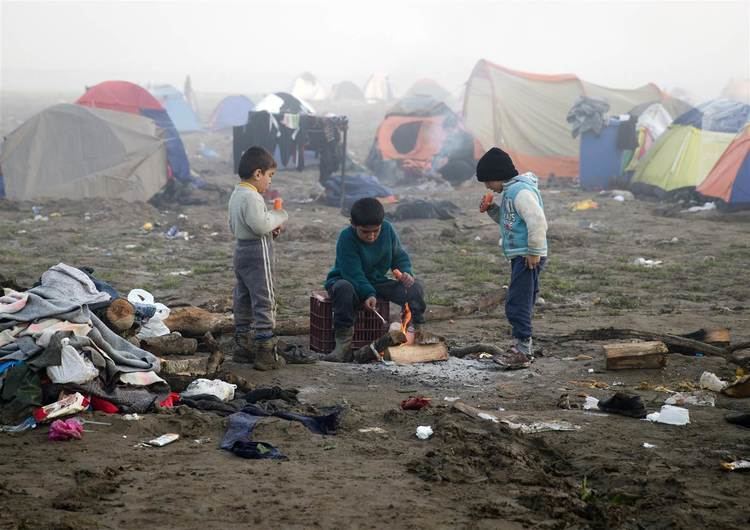Country Greece Regional unit Kilkis Time zone EET (UTC+2) Elevation 65 m Postal code 61400 | Administrative region Central Macedonia Municipal unit Axioupolis Vehicle registration KI Local time Friday 12:43 PM Municipality Paionia | |
 | ||
Weather 10°C, Wind N at 11 km/h, 77% Humidity | ||
Idomeni or Eidomene (Greek: Ειδομένη, [iðoˈmeni]) is a small village in Greece, near the borders with the Republic of Macedonia. The village is located in the municipality of Paeonia, Kilkis regional unit of Central Macedonia.
Contents
Map of Idomeni 614 00, Greece
The village is built at an elevation of 65 meters, in the outskirts of Kouri hill. It mounts in the west bank of Axios river, close to the border with Republic of Macedonia. The village is interwoven with a railway station, which is the first railway station that someone meets entering Greece from the north. The inhabitants of Idomeni are Macedonian Greeks/Slavophones, as well as descendants of refugees from East Thrace after the Population exchange between Greece and Turkey in 1923.
History
Eidomene is mentioned by Strabo at his work Geographica and by Thucydides at his work History of the Peloponnesian War.
Before 1926, it was also known as Sehovo (Greek: Σέχοβο, Bulgarian: Сехово, Macedonian: Сехово) or Seovo (Greek: Σέοβο), and it was renamed in 1936 to the namesake of the ancient Greek town "Idomene", which was mounted near the modern village. During the Greek War of Independence in 1821, the inhabitants of Sechovo/Idomeni (Sechovites) revolted against the Ottoman authorities, under Zafirios Stamatiades, one of the leaders who later fought in southern Greece. The village was destroyed by the Ottoman military authorities in 1824 as a retaliation for the participation in the revolt. From 1870 until the Balkan Wars, a lot of national conflicts between Greeks and Bulgarians took place in the village. In the book “Ethnographie des Vilayets d'Adrianople, de Monastir et de Salonique”, published in Constantinople in 1878, that reflects the statistics of the male population in 1873, Seovo was noted as a village with 85 households and 394 Bulgarian inhabitants. After the Russo-Turkish War (1877–78) the Bulgarian school in Sehovo was closed by Greek metropolitan bishop in Strumica.
At the Macedonian Revolt of 1878 against the Treaty of San Stefano, three people from the village joined armed rebel groups: Dellios Kovatsis, Stogiannis (Stoikos) Stoides and Nicolaos Stoides. During the Greek struggle for Macedonia a lot of inhabitants of Sechovo/Idomeni distinguished for their fighting for the Greek side, such as Georgios Stamatiades, his son Zafirios Stamatiades Papazafiriou, his grandsons Georgios Papazafiriou and Gregorios Papazafiriou, and also Stylianos Kovatsis. On the other hand, а committee of Internal Macedonian Revolutionary Organization (IMRO) was founded in 1895-1896. A lot of inhabitants of Sechovo distinguished for their fighting for the Bulgarian side, such as voyvode of IMRO Argir Manasiev (1872-1932), Dimitar Dzuzdanov (1887-1929), Grigor Totev (1868-1934), Gono Balabanov etc.
The "La Macédoine et sa Population Chrétienne" survey by Dimitar Mishev (D. Brankov) concluded that the Christian population in Sehovo in 1905 was composed of 1120 Bulgarian Exarchists.
Transportations
Close to Idomeni, there is the Railway Station of Idomeni, with trains to Thessaloniki, Belgrade and Central Europe.
Refugees
Since 2014, refugees from Syria, but also from Afghanistan, Pakistan and other countries of the Middle East, began to flock to Idomeni in order to cross the Greek borders and enter the Republic of Macedonia. Both the latter and Serbia to the north are out of the Schengen Area, which is why the refugees prefer this way to reach countries such as Germany and Sweden, so entering again the Schengen Area from Serbia; in case of arrest, they will be sent back to Croatia or Hungary (closer to their desired immigration destinations, especially Germany), and not to Greece, which is farther south. In 2015, the Former Yugoslav Republic of Macedonia decided to guard its borders by military forces in order to prevent the refugees from entering the country, as Serbia also closed its borders. Thus Idomeni became a vast camp, where many refugees entering Greece abide. The peak number of refugees who stayed in Idomeni numbered more than 15,000. On the 24th of May 2016, Greek authorities began relocating refugees from the Idomeni camp to processing facilities mostly in and around Thessaloniki.
